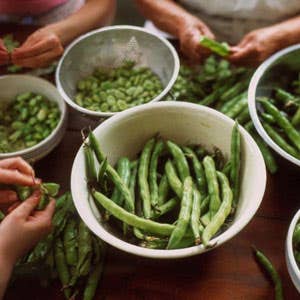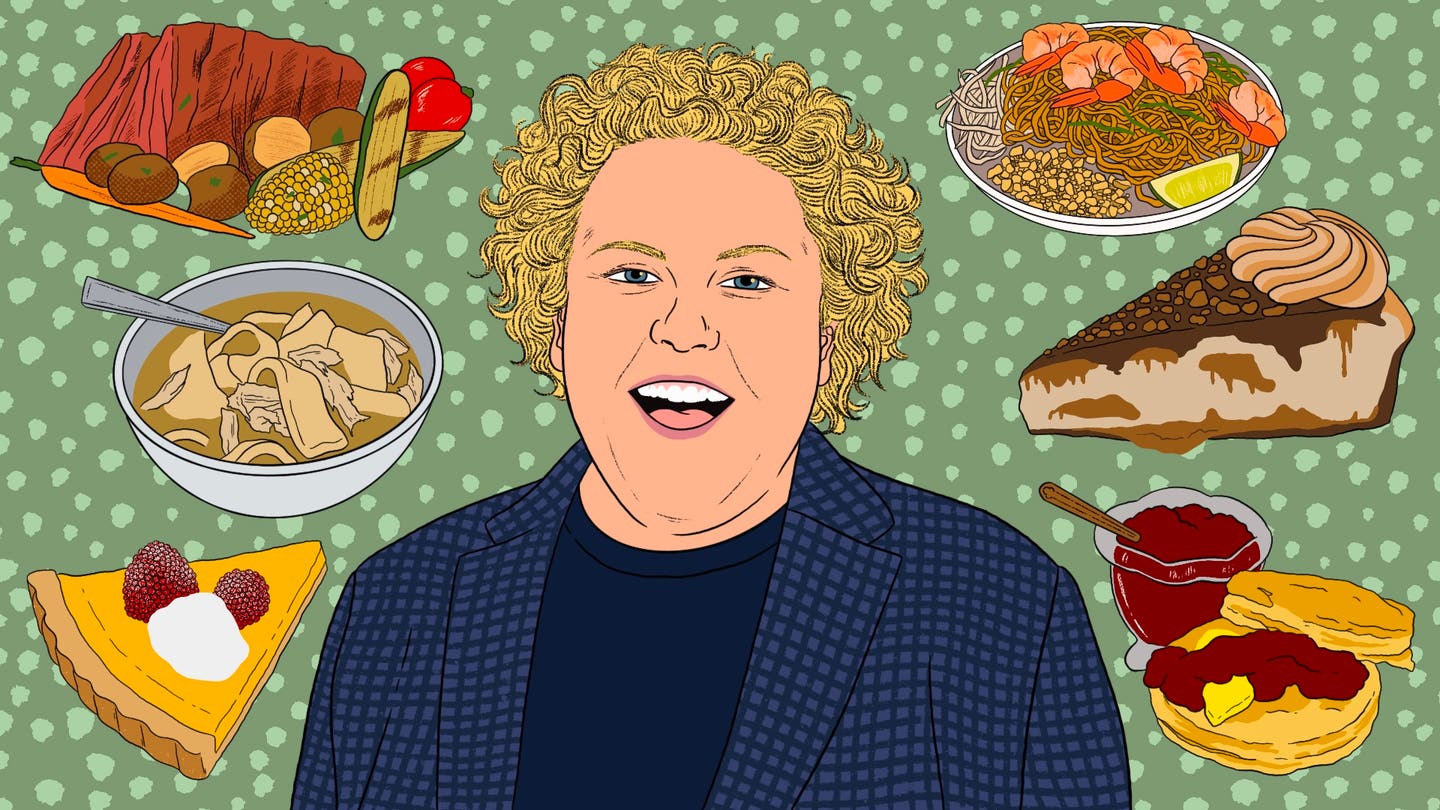
Fava Fever
All over the world, from the Mediterranean to China, from California to the Middle East, this ancient legume is a savory symbol of spring.
They're not the most easily accessible of vegetables: they come encased in sturdy pods, with thick skins that toughen into near invincibility as they mature; inside the pods, they nestle in individual little pockets lined with something very much like moist down; even once you get them out of there, which is no mean feat, they play hard to get, remaining cloaked in a chewy outer skin, so laborious to remove that in many parts of the world it is left on and just, well, chewed. The English call them broad beans; we call them favas.
The common fava, Vicia faba, is one of the oldest known cultivated food plants and one of the most prolific. Its origins have been variously ascribed to the Near East, Central or Southeast Asia, North Africa, and the eastern Mediterranean; it was widely cultivated (and eaten) in ancient Egypt and in Greece and Rome. Though we don't usually associate the fava with Chinese cuisine, it has been grown in China for more than a thousand years, and that country is today responsible for about 60 percent of the world's fava production.
To most Americans, fava beans remain a novelty. They are often confused with lima beans (which they resemble in shape and hue, though not in flavor) and consequently eschewed because of the negative connotations regrettably attached to that vegetable; or they're neglected because they're unfamiliar and unfriendly looking. But to the fortunate (comparative) few on these shores who have discovered how good favas can be, they have become a new favorite—earthy, vaguely metallic, faintly acidic, and delicious. The most important thing to remember, when you confront their daunting architecture, is that they are very much worth the trouble. (And in any case, see Getting to the Good Part of Favas for help dealing with them.) —Colman Andrews
A Legume for Catalan Palates
Called habas in Spanish, favas are grown all over Spain. The bulk of the production comes from the southern provinces of Seville, Almeria, and Murcia. But some maintain that Catalonia-grown favas (faves in Catalan)—and especially those from the fertile Llobregat River delta, with its saline subsoils and lower temperatures—are superior to all the others in taste and texture.
It certainly can't be denied that favas have long played a key part in Catalan gastronomy. Barcelona's Saint Medir, martyred in the fourth century while planting fava beans, is honored every March 3 with parades during which fistfuls of candies representing favas are pelted down upon clamoring children from horse-drawn carriages. In the 1320s, the Libre de Sent Sovi, Catalonia's earliest cookbook, offered a Lenten recipe involving fresh favas and almond milk. The revered 20th-century Catalan author Josep Pla, in El que hem menjat, or That Which We Have Eaten (Ediciones Destino, 1972), calls the fava the most Catalan of all foods, "only understood by the most demanding indigenous palates," and counsels that they should be consumed only in their tenderest infancy. (A saying from another part of Spain goes, "Habas de abril, para mi; las de mayo para el caballo"—"Fava beans in April are for me; those in May are for the horse.") —George Semler
The Poor Man's Meat
Fava beans are cultivated from one end of Italy to the other. In the south, they've long been known as la carne dei poveri, "the poor man's meat," and are the basis of many traditional dishes. One of the most famous is Sicily's u'maccu, a rough puree of boiled dried fava beans (and sometimes other legumes) dotted with pasta and flavored with borage and wild fennel, prepared on March 19 for the feast of Saint Joseph, whose divine intervention is said to have brought an end to a devastating famine in the Middle Ages.
Favas, called fave in Italian (from the Latin faba, or bean—or perhaps after the Fabii family, noble legume growers of ancient Rome), appear fresh in Italian markets, clothed in their bright green pods, from early March, when they begin to be harvested in the south, at least through the end of spring. The fresh beans are often braised with onions and pancetta and are essential to the spring vegetable soups and stews of central and southern Italy; Rome's vignarola combines them with peas, spring onions, artichokes, and romaine lettuce, while frittedda (or frittella), its Sicilian counterpart, flavors a similar mixture with mint leaves and nutmeg. The spring bread soups known as bazzoffia, from Rome, and garmugia, from the Tuscan town of Lucca, are variations on the theme.
In Tuscany, fava beans are called baccelli (Italian for pods) and are most often eaten tender and young, straight from the pod—and if possible from the garden—accompanied by marzolino, the tart, fresh pecorino cheese made with the milk of ewes that have grazed on fragrant spring grasses and herbs. —Lori Zimring De Mori
Harbinger of a Greek Spring
As I write this, in late winter, the stalls in the farmers' markets are heaped high with favas bulging in their pods, alongside radiant, spiky artichokes, bright spring carrots, pearly spring onions, young garlic stalks, and the first fragrant fronds of wild fennel. These are the harbingers of a Greek spring, yearly reminders that warm, sun-filled days are on their way.
Favas are among the oldest foods in Greece. They were well known in ancient times, and feared, especially among followers of Pythagoras, who believed that they contained the souls of the dead. It is said that Pythagoras himself, in fact, died at the edge of a field of favas. Contemporary Greeks no longer believe in the evils of favas, but they are well aware of the condition known as favism, an inherited red blood cell deficiency—occurring mostly in males of southern Mediterranean origin (including my young son)—which can induce, in consumers of favas, hemolytic anemia and jaundice.
While favas—koukia in Greek (fava, in Greece, is a dish based on dried peas)—are prepared all over the country, in everything from salads to stews, Crete is perhaps most closely associated with them. There, they are even savored raw—for example, with peppery local olive oil and shavings of sheep's milk cheese. Among traditional partners to the fava, in Crete and elsewhere, are the aforementioned artichokes, fennel, and carrots—and lemon juice, which livens up the bean's slightly musky flavor. Dried favas are also appreciated in Greece, eaten, among other ways, as koukofava—a dish of mashed favas accompanied by shamelessly pungent raw onions and salted sardines. —Diane Kochilas
A Favorite of the Pharaohs?
In Egypt, favas are a staple food, eaten fresh in season in early spring and dry the year round. There are several types, both small and large. The most common are the small Egyptian brown favas, used in their dry form for ful medames, the dish that is, for many Egyptians, both breakfast and the main meal of the day. A very large dry fava, on the other hand, is peeled and used to make the little deep-fried fritters, famous street food, called ta'ameyya or falafel.
Egyptians believe that favas were favorites of the pharaohs; indeed, they've been found in tombs from the pharaonic era. Biblical lore describes beans that were most likely favas as the food that the Israelites subsisted on as they trekked toward Jerusalem. Today some Sephardic communities celebrate Passover with a symbolic fava soup or other fava dish to commemorate their ancestors' exodus from Egypt. For the Christian Copts, direct descendants of the ancient Egyptians, favas are the essential protein that keeps them going during Lent, when they abstain from meat.
Many years ago, a place advertising itself as London's first Egyptian restaurant opened in one of the top hotels, to much razzmatazz. The decor was ancient Egyptian, as was the waiters' attire, and the dishes on the menu bore such names as Nefertiti Soup, Ramses Stew, and Horus Salad. The proprietors sent me an advance copy of the menu so that I might help them with the description of their regal-sounding dishes. More than half contained fava beans. —Claudia Roden
From Ethnic to Everyday
There's a saying in Northern California that you can tell a Portuguese home by the fava beans growing in the front yard. Italian immigrants may have been the first to cultivate them commercially in the state, but the Portuguese, primarily from the Azores, brought favas on ships in the Gold Rush days of the mid-19th century, and their descendants still prepare them in traditional ways: fried and salted into a sort of bar snack, pureed into a paste, or stewed with linguiça sausage.
Until relatively recently, Portuguese and other immigrant groups—including Italians and assorted Middle Easterners—were the only people in California who ate favas much, and few farmers grew them except as a cover crop. (Favas favor cooler climates; in California, they grow best near the coast, and Canada is a major fava producer.) It's hard to say exactly when favas made their shift from ethnic specialty to new-American mainstay, but it's possible that, as with so many other foods, the transition came by way of Chez Panisse. Judy Rodgers, of San Francisco's noted Zuni Cafe, remembers shelling favas when she worked at the Berkeley landmark in the early 1970s; the beans were virtually unknown in most West Coast restaurant kitchens at the time.
Today they are everywhere, a staple of California cooking. Typically, they're sauteed and served as a side dish or tossed into risottos and pastas, frequently in the company of other springtime ingredients, like morels, asparagus, or peas. Toward the end of their season, as the beans get tougher, they are more often pureed into a paste for crostini. And here's a trend alert: some Bay Area farmers have recently started selling fava greens, the leaves of the plant, as a spinach-like vegetable. —Carolynn Carreño
Keep Reading
Continue to Next Story










